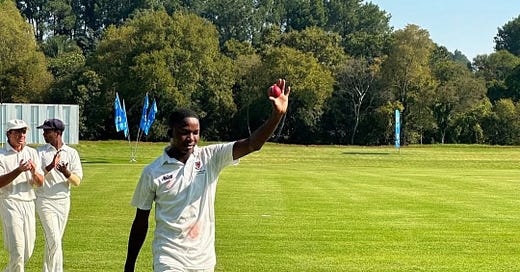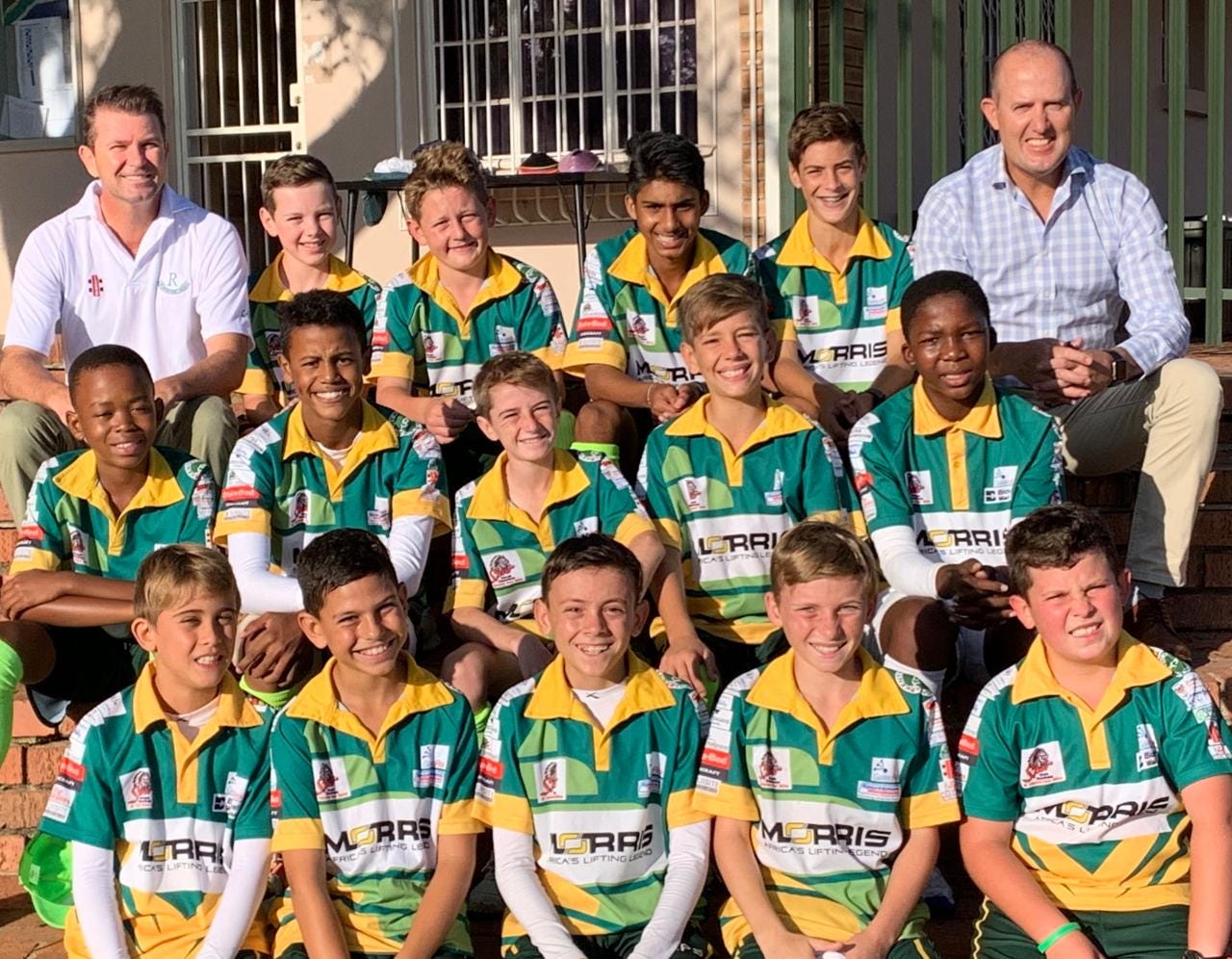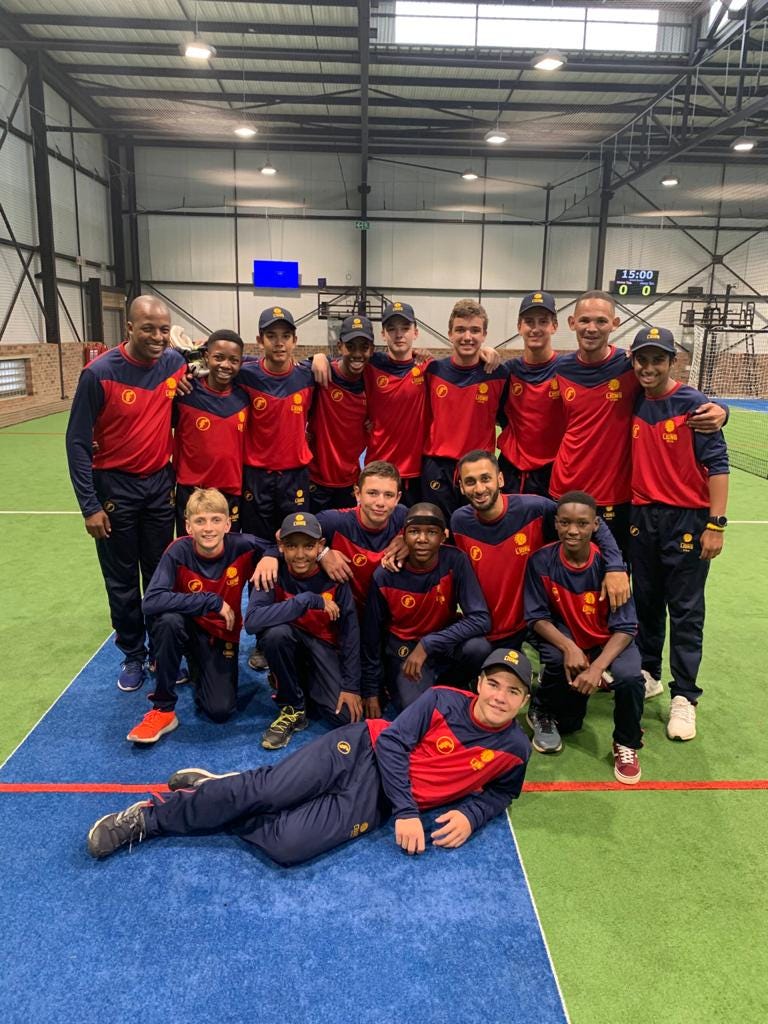From a distance, it looked like an idyllic scene: youngsters enjoying an impromptu game of cricket under the trees. Up close, Kwena Maphaka was ambling in, and batters were fighting for their lives. Seven-year-old Maphaka was supposed to help the U13 players warm up for their match, but instead, he was launching mini rockets at them.
Youngsters are excitable and can make mediocre executions feel like world-class performances. When three of them ran to Andrew Crole, asking him to look at the kid putting on a bowling masterclass, he reluctantly agreed. Crole felt both deja vu and jamais vu.
He had seen this run-up before, it was short and almost languid. However, all hell broke loose when the youngster got into his imperfect delivery stride. "I knew immediately that he was a star. He was bowling from an eight-metre length, with a straight arm and decent pace," Crole shared.
The last time Crole saw a young pacer and knew he was special was in 2005. Kagiso Rabada's school, Bryanston Parallel Medium, didn't have state-of-the-art cricket facilities. They used Rivonia Primary's, down the road. Crole worked hand-in-hand with the Bryanston coach. However, he made a mistake with Rabada. He didn't pay enough attention to the youngster's action.
Had he done so, he would have seen that Rabada's action was mixed and not effective. Thankfully, Wim Jansen fixed that when the Proteas star got to St Stithians, but it wasn’t before Rabada missed out on provincial colours at u13 because he lacked consistency and also had to sit out the first half of his u14 year because of back strain.
Maphaka's back foot was the first thing Crole looked at when the youngster showed up for his first practice with the first team a few years later. There were no issues on that front. The junior coaches had done well. Maphaka's landing was decent from the onset, however, they needed to work on his delivery points and angle of run-up.
Training sessions were two hours and Maphaka wanted to bowl for three hours. However, Crole didn't allow him that luxury. At training, Maphaka bowled for 15 minutes, batted for another quarter of an hour and then did some fielding drills. And then repeat.
Maphaka wanted to bowl all the overs during matches. Fortunately, cricket rules do not allow that. Crole deployed him in short spells with the new ball and often came back at the death. Sometimes he didn't get to bowl at the death because Crole saw no value if the opposition’s backs were against the ropes.
"We didn't bowl him when the match was won. It was pointless. Yes, he would get wickets, but they were low value and did nothing to help him," Crole explained.
When he started his cricket journey, his hunger was driven by a desire to be as good as his overachieving brother, Tetelo. As a Rivonia Primary first XI player, his hunger came from a desire to have a big impact on the game. Crole’s decision to manage his workload by bowling him when it mattered made Maphaka hungrier.
Rivonia lost matches with Maphaka in the side. They also won a lot with him leading the bowling attack. One thing was consistent in both instances: Maphaka had a glint in his eye when he took the ball. He also ran in determined to make a difference, and one match stands out for Crole.
Rivonia was up against it. Their opposition needed 15 runs with eight wickets in hand. Maphaka came on and it looked like he was bowling on an eight-metre long wicket. The batters tried but were unsuccessful in their efforts to survive. The left-armer did not take wickets in his opening spell but finished the match with six wickets. Rivonia won by four runs.
Between Innings will always cover cricket through a longform lens, and it is completely fueled by you. Subscribe, share and buy a drink - it all helps.
Curtly Ambrose didn't talk much but he looked at batters a lot. He possessed a stare that sent a chill down your spine. It left batters wondering if Ambrose's next delivery would be an attempt to dismiss them or one to hurt them physically. The tall Antiguan was two-and-a-bit metres of arms and legs and possessed a whiplash wrist. In 1988, he imprinted a nightmare on Australian fans after he broke Geoff Lawson's jaw with an on-target steepling bouncer.
Kwena Maphaka bagged seven wickets in three outings at the 2022 u19 World Cup. He loved every moment of being on the park and celebrated every wicket with intensity. However, his best moment of the whole tour was meeting Sir Curtly Ambrose. His admiration of the West Indies legend went back to when he was around six or seven.
Back then, Tetelo was enamoured by West Indian pacers from their era of greatness. Tetelo was Maphaka's first hero, and he emulated whoever Tetelo looked up to. The Antiguan stood out for Maphaka, he was one of his heroes, alongside Mitchell Johnson, Brett Lee, Dale Steyn and Kagiso Rabada.
"He loved the passion and aggression they bowled with and how they intimidated batters with raw pace and their thinking," Tetelo shared.
Tetelo was a left-arm medium pacer before Crole convinced him to become a left-arm orthodox spinner. Before his conversion, Tetelo engaged in competitions with his friends to see who could bowl the fastest. Maphaka, who saw himself in the quintet of Ambrose, Johnson, Lee, Steyn, and Rabada, always turned up to compete with them. He believed that he was faster than Tetelo and his friends, oblivious to the fact that he was six years younger than Tetelo and company.
In 2017, Maphaka proved he was too good and too fast for his age group when he almost re-enacted the Ambrose-Lawson moment. Maphaka banged in a short delivery too quick for the batter to take evasive action. The youngster’s jaw was saved by the grill, which Maphaka broke.
The Gauteng Lions have 148 affiliated schools and numerous hubs. In 2018, the union selected a single team for the u13 age group. Maphaka was selected for that team when he was 12. He outperformed the bowlers in his year and the guys a year older.
Even at that age, Maphaka approached training sessions with a level of professionalism that belied his age. None of the coaches Maphaka has worked with takes credit for his attitude. Andrew Crole, Ahmed Nawab, Bryan Patel and Wim Jansen, all point to the Maphaka household as the source of his character.
"I remember speaking to his mum, when he was 12, about seeing a biokineticist to get stronger and work on his physical appearance. She made sure he started that journey immediately," Ahmed Nawab, the Lions u19 coach, shared.
Maphaka’s parents never played cricket and they did not watch it. Not before their sons started playing. They were more inclined towards football and athletics. They learned cricket through Tetelo and then later on their sons. They went to every match, were attentive to their sons’ needs and did not put pressure on them to excel.
Maphaka’s mother mirrored her son’s commitment. Crole, who taught Maphaka maths at Rivonia, described Maphaka the student as a meticulous and diligent young man. The biokineticist’s report to Nawab told a similar story. Maphaka was a joy to work with. Malibongwe Maketa, the CSA high-performance coach, had a similar experience. At the u19 World Cup, he gave each team member an information pack: notes on opposition players and video analysis footage.
"Kwena always turned to the next team meeting with bowling plans for the entire batting lineup, including the number 11," Maketa shared.
“He has always been a bit of a nerd when it comes to cricket. When he is not watching greats from the past, he is studying the opposition, trying to learn their strengths and weaknesses,” Tetelo explained.
Maketa and his high-performance team created a Player Performance Plan for Maphaka. He had to log the number of overs he delivered and the intensity he bowled at for St Stithians, the Lions and club cricket. To use Maketa's words, he did everything to a T.
“He was an outstanding young professional. He understood that all of this was there to help him as a cricketer,” Maketa explained.
Maphaka’s pitch map from his u15 year was a mixed bag of every line and length conceivable. Nawab and Patel were not worried about that. They wanted him to bowl quick. They wanted him to get comfortable with delivering high pace. In their sessions, Patel helped Maphaka with his alignment, but the Gauteng Lions junior coach encouraged him to focus on speed.
“We noticed pretty early on that Kwena was a special young man. That’s why Shukri Conrad wanted him in the u19 World Cup squad at 16. We were fortunate that there was buy-in from the Lions and St Stithians, they worked hard to stick to the plan we had for his development,” Maketa shared.
Maphaka's regime changed in the run-up to the 2022 Khaya Majola Week. The focus was now on hitting the stumps more regularly. Maphaka was relentless. They had countless sessions of just targeting the stumps. They wanted the youngster to repeatedly hear the sound of the ball hitting the timber. He enjoyed it. However, the numerous batters who got accustomed to hearing that sound at Khaya Majola Week did not share his enjoyment.
Kwena Maphaka had arrived.








Great read. Awesome to see Maphaka making some appearances for South Africa's white ball teams. Excited to follow his career